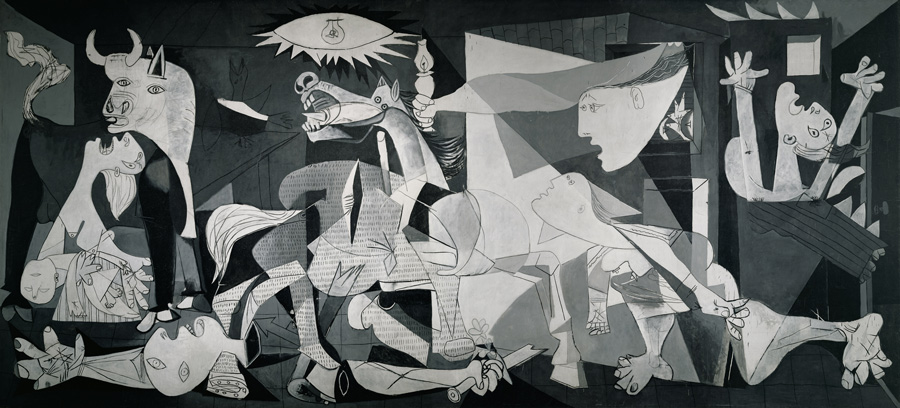Guernica on American tour
A year later, Dudensing arranged the gallery’s third and final Picasso retrospective: twenty-one paintings dating from 1908 to 1934, nine of which were loans from private New York collections. Highlights included Cubist works from the collections of George L. K. Morris: Le Poète, 1911 (Z.IIa,285) and Walter P. Chrysler, Jr.: L’Indépendant, 1911 (Z.IIa,264). Mary Hoyt Wiborg loaned her still life, Grand nature morte, 1922 (Z.V,228) and Stephen Clark anonymously loaned La Statuaire, 1925 (Z.V,451). After noting that the show included no examples from the Blue and Rose periods which he considered to be the artist’s best, critic Howard Devree dismissively concluded that there was nothing on view that would add to the “average gallery-goer’s knowledge of the artist’s work.”[i]
The final Picasso exhibition at the Valentine Gallery—undoubtedly the crowning moment of Dudensing’s career—was the May 1939 showcasing of Guernica (Z.IX,65) at the start of its U.S. tour. The Museum of Modern Art’s new building on West 53rd Street opened with great fanfare that same month and many assumed that this is where the masterpiece would be displayed. Because the purpose of the tour was to raise funds for refugees fleeing Spain’s Civil War, however, Picasso expressly did not want the painting shown at the museum. Guernica’s tour was organized in conjunction with the American Artists’ Congress chaired by Sidney Janis. Janis selected the Valentine Gallery as the painting’s New York venue not only because the gallery’s main room could accommodate the painting’s size (11 x 25 feet) but also in recognition of Dudensing’s relationship and history with the artist and his work.[ii] The gala opening on May 4, 1939 was attended by nearly one hundred guests, including: the former premier of the Spanish Republic, Juan Negrín; first lady Eleanor Roosevelt; Secretary of the Interior Harold Ickes; and New York society’s elite, such as: Stephen C. Clark, Simon Guggenheim, W. Averell Harriman, Georgia O’Keeffe and William S. Paley.[iii]
A number of artists were among the two thousand visitors who paid the fifty-cent admission fee to see Guernica during the show’s nearly four-week run in New York. A few recounted their first impressions of the mural-sized painting. Elaine and Willem de Kooning visited together and Elaine recalls, “We were stunned—really bowled over—by Guernica. Talk about passion. It was just pouring out of that enormous painting. Bill and I just stood before it—in awe, in wonder, and in a kind of terror. We didn’t talk for a long time.”[iv] Profoundly impacted by the painting, Jackson Pollock visited the gallery repeatedly, analyzing the components of the work through a series of sketches.[v] Lee Krasner, his wife, verbalized the impact that the painting had on her:
Picasso by then was one of my heroes in painting. But I remember opening the door of the Dudensing-Valentine Gallery, walking in and this ‘thing’ was just there at the entrance. I turned right around, walked out, circled the block three times before I dared walk in and really look at it. That’s the effect it had on me.[vi]
[i] “A Reviewer’s Notebook,” New York Times (November 13, 1938), 10X.
[ii] Herschel B. Chipp, Picasso’s Guernica: History, Transformations, Meanings (Berkeley: University of California Press, 1988), 161.
[iii] IBID.
[iv] Lee Hall, Elaine and Bill, Portrait of a Marriage: The Lives of Willem and Elaine de Kooning (New York: Harper Collins, 1993), 163; reprinted in Mark Stevens and Annalynn Swan, De Kooning: An American Master (New York: Alfred A. Knopf), 164.
[v] Steven Naifeh and Gregory White Smith, Jackson Pollock: An American Saga (New York: Clarkson N. Potter, 1989), 349.
[vi] Ellen G. Landau, Lee Krasner: A Catalogue Raisonné (New York: Abrams, 1995), 55.





 índice
índice